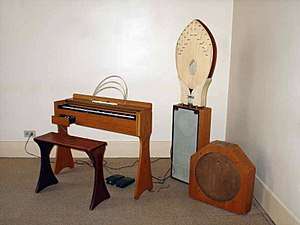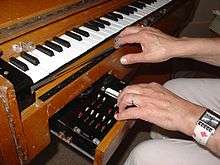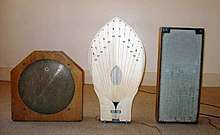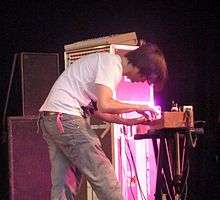Ondes Martenot
The ondes Martenot (/ˈoʊnd mɑːrtəˈnoʊ/ OHND mar-tə-NOH; French: [ɔ̃d maʁtəno], "Martenot waves") or ondes musicales ("musical waves") is an early electronic musical instrument. It is played with a keyboard or by moving a ring along a wire, creating "wavering" sounds similar to a theremin. A player of the ondes martenot is called an ondist.
| Ondes Martenot | |
|---|---|
 An ondes Martenot (seventh generation model, 1975) | |
| Dates | 1928–present |
| Technical specifications | |
| Polyphony | none[1] |
| Oscillator | vacuum tube |
| Synthesis type | heterodyne |
| Input/output | |
| Keyboard | 72-note rail-mounted keyboard capable of producing vibrato via lateral motion |
The ondes Martenot was invented in 1928 by the French inventor Maurice Martenot. Martenot was inspired by the accidental overlaps of tones between military radio oscillators, and wanted to create an instrument with the expressiveness of the cello.
The instrument is used in more than 100 classical compositions. The French composer Olivier Messiaen used it in pieces such as his 1949 symphony Turangalîla-Symphonie, and his sister-in-law Jeanne Loriod was a celebrated player of the instrument. It appears in numerous film and television soundtracks, particularly science fiction and horror films. Jonny Greenwood of the English rock band Radiohead is credited with bringing the ondes to a larger modern audience. It has also been used by pop artists such as Daft Punk and Damon Albarn.
History
The ondes Martenot (French for "Martenot waves") is one of the earliest electronic instruments,[2][3][4] patented in the same year as another early electronic instrument, the theremin.[2] It was invented in 1928 by French cellist Maurice Martenot.[2] Martenot had been a radio operator during World War I, and developed the ondes Martenot in an attempt to replicate the accidental overlaps of tones between military radio oscillators.[2] He hoped to bring musical expressivity associated with the cello to his new instrument.[5] He first demonstrated the ondes Martenot on April 20, 1928,[6] performing Dimitrios Levidis’s Poème symphonique at the Paris Opera.[7]
Units were manufactured individually to order.[6] Over the following years, Martenot produced several new models, introducing the ability to produce vibrato by moving the keys, a feature adapted in the 1970s by some Yamaha GX-1 synthesisers.[3] According to The Guardian, the ondes Martenot visually resembles a cross between an organ and a theremin.[2]
Jean-Louis Martenot, Maurice Martenot's son, created new ondes Martenot models.[3] In 2000, Jonny Greenwood of the English rock band Radiohead commissioned the synthesiser company Analogue Systems to develop a replica of the ondes Martenot, as he was nervous about damaging his instrument on tour. The replica, called the French Connection, imitates the ondes Martenot's control mechanism, but does not generate sound; instead, it may be used to control an external oscillator.[3]
Sounds and technique

The ondes Martenot is unique among electronic musical instruments in its methods of control.[8] The ondes Martenot can be played with a metal ring worn on the right index finger. Sliding the ring along a wire produces "theremin-like" tones, generated by oscillations in vacuum tubes,[2] or transistors in the seventh model.[9]
The third model of the instrument, unveiled in 1929, had a non-functioning simulacrum of a keyboard below the wire to indicate pitch.[10] This model also had a "black fingerguard" on a wire which could be used instead of the ring. It was held between the right thumb and index finger, which was played standing at a distance from the instrument. When played in this way, the drawer is removed from the instrument and placed on a bench next to the player. Maurice Martenot's pedagogical manual for the ondes Martenot, written in 1931, offers instruction on both methods of playing.[11]
Later versions added a real functioning keyboard;[10] the keys produce vibrato when moved from side to side. This was introduced in the 1930s with the 84-key fourth version of the instrument.[12][13] Subsequent versions had 72 keys. Combined with a switch that transposes the pitch by one octave, these instruments have a range from C1 to C8.[14]
A drawer allows manipulation of volume and timbre by the left hand.[15] Volume is controlled with a touch-sensitive glass "lozenge"[2], called the "gradation key"; the further the lozenge is depressed, the louder the volume. In his preface to Jeanne Loriod's Technique de l'Onde Electronique Type Martenot., Olivier Messiaen explains that the "gradation key, struck by one or several fingers of the left hand, gives at the same time the sound, its intensity, and the attack itself. The intensity ranges from an almost inaudible pianissimo to the most terrible and painful fortissimo, passing through all intermediate gradations. The conceivable attacks are more numerous than those of the piano, violin, flute, horn or organ – they range from an absolute legato and glissando to the sounds of temple blocks and membranophones. Somewhere beyond the absolute legato exists an extraterrestrial, enchanted voice, and beneath the dry staccato attack may be found sound effects such as cracked bell, a crumbling pile of sand, or an aircraft motor."[16] Early models could produce only a few waveforms.[15] Later models can simultaneously generate sine, peak-limited triangle, square, pulse, and full-wave rectified sine waves, in addition to pink noise, all controlled by switches in the drawer.[17] The square wave and full-wave rectified sine wave can be further adjusted by sliders in the drawer. On the Seventh model, a dial at the top of the drawer adjusts the balance between white noise and the other waveforms. A second dial adjusts the balance between the three speakers. A switch chooses between the keyboard and ribbon.[18]
Further adjustments can be made using controls in the body of the instrument. These include several dials for tuning the pitch, a dial for adjusting the overall volume, a switch to transpose the pitch by one octave, and a switch to activate a filter.[18]

The drawer of the Seventh model also includes six transposition buttons, which change the pitch by a specific interval. These are called -1/4 (lower by one quarter tone), +1/4 (raise by one quarter tone), +1/2 (raise by one semitone), +1 (raise by one whole tone), +3ce (raise by one major third), and +5te (raise by one major fifth.[20] These can be combined to immediately raise the pitch by up to a minor ninth.[21]
Martenot produced four speakers, called diffuseurs, for the instrument.[22] The Métallique features a gong instead of a speaker cone, producing a metallic timbre. It was used by the first ondes Martenot quartets in 1932.[12] Another, the Palme speaker, has a resonance chamber laced with strings tuned to all 12 semitones of an octave; when a note is played in tune, it resonates a particular string, producing chiming tones.[2][23] It was first presented alongside the sixth version of the ondes Martenot in 1950.[24]
According to the Guardian, the ondes Martenot "can be as soothing and moving as a string quartet, but nerve-jangling when gleefully abused".[2] Greenwood described it as "a very accurate theremin that you have far more control of ... When it's played well, you can really emulate the voice."[23] The New York Times described its sound as a "haunting wail".[6]
Use
Classical music
The ondes Martenot is used in more than 100 classical compositions,[3] most notably by the French composer Olivier Messiaen. Messiaen first used it in Fête des Belles Eaux, for six ondes,[25] and went on to use it in several more works, including Trois Petites Liturgies de la Présence Divine and Saint-François d'Assise. For his Turangalîla-Symphonie, Messiaen used to create "shimmering, swooping musical effects".[6] Messiaen's widow, Yvonne Loriod-Messiaen, arranged and edited four unpublished Feuillets inedits for ondes Martenot and piano which were published in 2001.[26]
Other composers who used the instrument include Arthur Honegger, Darius Milhaud, Edgard Varèse, Charles Koechlin, Florent Schmitt and Jacques Ibert.[6]
According to the New York Times, the ondes' most celebrated performer was the French musician Jeanne Loriod (1928–2001), who studied under Martenot at the Paris Conservatory. She performed internationally in more than 500 works, created 85 works for a sextet of ondes she formed in 1974, and wrote a three-volume book on the instrument, Technique de l'Onde Electronique Type Martenot.[6]
The English composer Hugh Davies estimated that more than 1,000 works had been composed for the ondes.[6] Jeanne Loriod estimated that there were 15 concertos and 300 pieces of chamber music.[6]
Thomas Adès's opera The Exterminating Angel features an ondes Martenot, which Adès says "could be considered the voice of the exterminating angel".[27]
Popular music

One of the first integrations of the ondes Martenot into popular music was done in French chanson during the fifties and sixties. For example in some of Baudelaire's poems set to music by French singer Léo Ferré in his albums Les Fleurs du mal (1957)[28] and Léo Ferré chante Baudelaire (1967), or in popular dramatic lovesong Jacques Brel's "Ne me quitte pas" (1959).[29] During the seventies Beau Dommage and Harmonium, the two most popular musical groups of the Quebec musical scene, made extensive use of this instrument (introduced there by Marie Bernard) in each of their 1975 albums, respectively Où est passée la noce?[30] and Si on avait besoin d'une cinquième saison.[31]
Jonny Greenwood of the English rock band Radiohead is credited with bringing the ondes to a larger audience. He first used it on Radiohead's 2000 album Kid A, and it has appeared in many of their songs, including "The National Anthem", "How to Disappear Completely", and "Where I End and You Begin".[10] Radiohead have performed versions of their songs "How to Disappear Completely" and "Weird Fishes / Arpeggi" using several ondes Martenots.[2] On their 2001 album Amnesiac, they used the ondes martenot palm speaker to add a "halo of hazy reverberance" to Thom Yorke's vocals on the song "You and Whose Army?".[23] Greenwood also composed a piece for two ondes Martenots, Smear.[32]
The ondes Martenot was used by Joe Jackson on his albums Tucker (1988),[33] and Night Music (1994)[34] and by Bryan Ferry on the 1999 album As Time Goes By.[35] Ondist Thomas Bloch toured in Tom Waits and Robert Wilson's show The Black Rider (2004–06)[36] and in Damon Albarn's opera "Monkey: Journey to the West" (2007–2013).[37] Bloch performed ondes Martenot on the 2013 Daft Punk album Random Access Memories.[10]
The French composer Christine Ott released in 2020 Chimères (pour Ondes Martenot), an electronic avant-garde album entirely conceived using only the Ondes Martenot.[38]
Film and television
The ondes Martenot has featured in many films, particularly science fiction and horror films.[10] In 1936 Adolphe Borchard used it in Sacha Guitry's Le roman d'un tricheur, played by Martenot's sister, Ginette.[39] It was used by composer Brian Easdale in the ballet music for The Red Shoes.[40] French composer Maurice Jarre introduced the ondes Martenot to American cinema in his score for Lawrence of Arabia (1962).[41] The English composer Richard Rodney Bennett used it for scores for films including Billion Dollar Brain (1967) and Secret Ceremony (1968).[42] Elmer Bernstein learned about the ondes Martenot through Bennet, and used it in scores for films including Heavy Metal,[43] Ghostbusters,[44][45] The Black Cauldron,[45] and My Left Foot.[45]
Director Lucille Hadžihalilović decided to use the instrument in her film Evolution (2015) as it "brings a certain melancholy, almost a human voice, and it instantly creates a particular atmosphere".[46] Other film scores that use the ondes Martenot include A Passage to India, Amelie, Bodysong,[2] There Will Be Blood (2007) and Hugo (2011).[47]
The ondes Martenot is the subject of the 2013 Quebec documentary Wavemakers.[48] It is used in a performance of Messiaen's Quartet for the End of Time in an episode from the third season of the Amazon series Mozart in the Jungle, where a musician plays the ondes Martenot to inmates on Rikers Island.[49][50]
The British composer Barry Gray studied the instrument with Martenot in Paris, and used it in his soundtracks for 1960s films including Dr Who and the Daleks, and Doppelgänger.[3] The ondes martenot is sometimes reported as having been used in the original Star Trek theme; in fact, the part was performed by a singer.[2]
Legacy
In 2001, the New York Times described the ondes, along with other early electronic instruments such as the theremin, teleharmonium, trautonium, and orgatron, as part of a "futuristic electric music movement that never went remotely as far as its pioneers dreamed ... proponents of the new wired music delighted in making previously unimaginable noises".[6] The French classical musician Thomas Bloch said: "The ondes martenot is probably the most musical of all electric instruments ... Martenot was not only interested in sounds. He wanted to use electricity to increase and control the expression, the musicality. Everything is made by the musician in real time, including the control of the vibrato, the intensity, and the attack. It is an important step in our electronic instrument lineage."[10]
According to music journalist Alex Ross, fewer than 100 people have mastered the instrument.[51] In 1997, Mark Singer wrote for The Wire that the ondes would likely remain obscure: ''The fact is that any instrument with no institutional grounding of second- and third-raters, no spectral army of amateurs, will wither and vanish: how can it not? Specialist virtuosos may arrive to tackle the one-off novelty ... but there's no meaningful level of entry at the ground floor, and, what's worse, no fallback possibility of rank careerism if things don't turn out.''[6]
In 2009, the Guardian reported that the last ondes Martenot was manufactured in 1988, but that a new model was being manufactured.[2] In 2011, Sound on Sound wrote that original ondes Martenot models were "all but impossible to obtain or afford, and unless you can stump up 12,000 Euros for one of Jean‑Loup Dierstein's new reproduction instruments, the dream of owning a real Ondes is likely to remain such".[3] In 2012, the Canadian company Therevox began selling a synthesizer with an interface based on the ondes Martenot pitch ring and intensity key.[52] In 2017, the Japanese company Asaden manufactured 100 Ondomo instruments, a portable version of the ondes Martenot.[53]
The ondes Martenot's electronics are fragile, and it includes a powder which transfers electric currents, which Martenot would mix in different quantities according to musicians' specifications; the precise proportions are unknown. Attempts to construct new ondes Martenot models using Martenot's original specifications have been mixed.[10]
References
- Sibyl Marcuse, "Ondes Martenot", Musical Instruments: A Comprehensive Dictionary, corrected edition (New York: W. W. Norton 7 Company, Inc., 1975): 377.
- McNamee, David (12 October 2009). "Hey, What's That Sound: Ondes Martenot". The Guardian. Retrieved 7 September 2018.
- Reid, Gordon (February 2002). "Analogue Systems French Connection". Sound on Sound. Retrieved 24 July 2018.
- Ross, Alex (21 August 2001). "The Searchers: Radiohead's unquiet revolution". The New Yorker. Archived from the original on 25 May 2007. Retrieved 14 June 2007.
- Jean Laurendeau: Maurice Martenot: Luthier de l'Electronique (Dervy Livres, 1996)
- Martin, Douglas (19 August 2001). "Jeanne Loriod, Who Transformed Electronic Wails Into Heartfelt Music, Dies at 73". New York Times. Retrieved 25 July 2018.
- "The Musical Times: Jeanne Loriod 1928–2001". 26 December 2009. Archived from the original on 26 December 2009. Retrieved 2 August 2018.
- Loriod, Jeanne (1987). Technique de l'onde electronique type martenot. Paris: Alphonse Leduc. ISMN 979-0-04-626275-3.
- Loriod 1987, p. III Ondes Musicales by Dierstein, Thomas Bloch, 2018
- Loriod 1987, p. VIBattaglia, Andy (6 March 2014). "Ondes Martenot: An Introduction". Red Bull Music Academy. Retrieved 25 July 2018.
- Martenot 1931, pp. 39–40.
- Loriod 1987, p. VII.
- "Détail du document ONDES MARTENOT". cité de la musique philharmonie de paris. 2018.
- Loriod 1987, p. XIII.
- Martenot 1931, pp. 14–15.
- Loriod 1987, p. III.
- Loriod 1987, pp. XVI-XX.
- Loriod 1987, p. XX.
- Loriod 1987, p. XV.
- Loriod 1987, pp. XX-XXI.
- Loriod 1987, p. 72.
- Loriod 1987, pp. VI-XVII.
- Reynolds, Simon (July 2001). "Walking on Thin Ice". The Wire. Archived from the original on 4 February 2012. Retrieved 17 March 2007.
- Loriod 1987, p. VIII.
- Hill, Peter; Simeone, Nigel (2005). Messiaen. Yale. pp. 74–75. ISBN 978-0-300-10907-8.
- Bloch, p. 7.
- "Hear the Surreal Instruments of the Met's New Opera". The New York Times. The New York Times.
- Léo Ferré (10 Apr 2008) [reissue from 1957 album], Les Fleurs Du Mal (CD, Album, Remastered), La Mémoire Et La Mer, 19 956,
Track 3. Les Hiboux, 10. La Vie Antérieure, 11. La Pipe'
- Jacques Brel (Nov 1959), N° 4 (Vinyl, Album), Philips, B 76.483 R,
Track A5. Ne Me Quitte Pas – Music By [Uncredited] – Gérard Jouannest, Ondes Martenot [Uncredited] – Sylvette Allart
- Beau Dommage (1975), Où Est Passée La Noce? (Vinyl, Album), Capitol Records / EMI, SKAO 70.037,
Track B1. En Pleine Face – ... Ondes Martenot – Marie Bernard ...
- Harmonium (1975), Les Cinq Saisons (Vinyl, Album), Celebration, CEL-1900,
Track B: Un Incident À Bois-Des-Filions – ... Ondes Martenot – Marie Bertrand, ..."
- Jonny Greenwood's "smear" to Receive US Premiere at New York's SONiC Festival, Nonesuch Records, October 17, 2011,
Greenwood's smear is scored for large ensemble and two ondes Martenots, early electronic instruments that Greenwood often uses with Radiohead. ...
- Joe Jackson (1988), Tucker: The Man And His Dream (Original Motion Picture Soundtrack) (Vinyl, LP, Album), A&M Records, SP-3917,
Credits: Ondes Martenot – Arlette Fibon
- Joe Jackson (1988), Night Music (CD, Album), Virgin Records America, 7243 8 39880 2 0,
Credits: Ondes Martenot – Jean Laurendeau (tracks: 1,10)
- Bryan Ferry (1999), As Time Goes By (CD, Album), Virgin, DGVIR89,
Credits: Ondes Martenot – Cynthia Millar
- Robert Simonson (9 September 2004), Tom Waits' Black Rider Extends Again at ACT, Playbill.com, archived from the original on 29 June 2011, retrieved 7 June 2012,
The score of The Black Rider calls for an eclectic pit of such instruments as the toy piano, the pocket trumpet, the Stroh violin, the Ondes Martenot, the glass harmonica, the Cristal Baschet, the drunk piano and the musical saw.
- Ivan Hewett (23 Jun 2007), "A whole new aria for Damon", The Daily Telegraph,
He shows me some of the instruments in the ensemble: there's a glass harmonica, which looks like a giant ribbed glass vase tipped on one side, and an ondes Martenot, the tremulous 1920s electronic instrument. ...
- Ingalls, Chris (27 May 2020). "Christine Ott Brings the Ondes Martenot to New Heights with the Mesmerizing 'Chimères'". Popmatters.
- Philippe Langlois (2012). Les Cloches d’Atlantis. Musique électroacoustique et cinéma. Archéologie et histoire d’un art sonore. Paris: Éditions MF. p. 119.
- "Brian Easdale at the Proms". www.powell-pressburger.org. Retrieved 2018-09-07.
- Mervyn Cooke (2008). A History of Film Music. Cambridge and New York: Cambridge University Press. p. 333.
- Ross Care and Lukas Kendall, "Billion Dollar Brain FSM Online Liner Notes Film Score Monthly (2008).
- Interview with Dan Goldwasser, originally published on SoundtrackNet, July 2000 Archived 2012-02-29 at the Wayback Machine
- Interview with Randall D. Larson, originally published in CinemaScore #13/14, 1985
- "Bernstein biography from official site". Archived from the original on 2014-10-06. Retrieved 2014-02-11.
- "Evolution: Interview with Lucile Hadzihalilovicz". Electric Sheep. 2016-05-06. Retrieved 2017-10-03.
- Howard Shore, Hugo – Original Score, CD booklet, published by Paramount Pictures in the year 2011
- Dunlevy, T'cha (13 March 2013). "Review: Le chant des Ondes". Montreal Gazette. Retrieved 28 November 2014.
- "New Season of 'Mozart in the Jungle' Features a Unique Performance". WQXR. Retrieved 2017-10-27.
- "How 'Mozart in the Jungle' Brought an Obscure, Avant-Garde Piece of Classical Music to Rikers Island". Flavorwire. 2016-12-13. Retrieved 2017-10-27.
- Ross, Alex (21 August 2001). "The Searchers: Radiohead's unquiet revolution". The New Yorker. Archived from the original on 25 May 2007. Retrieved 14 June 2007.
- Laurendeau, Jean (2017). Maurice Martenot: Luthier de l’électronique. Beauchesne éditeur. p. 367.
- "Ondomo is revitalising a 90-year-old electronic instrument". Sound on Sound. 22 April 2017. Retrieved 5 September 2018.
- Martenot, Maurice (1931). Methode pour l'enseignement des ondes musicales: instrument radio-électrique martenot [Method for Teaching the Ondes Martenot: Martenot's Radioelectric Instrument] (in French). Paris: Alphonse Leduc. ISMN 979-0-04-617828-3.
- Thomas Bloch, insert notes to Naxos Records CD 8.555779 "Music for ondes Martenot"
Further reading
- Orton, Richard, and Hugh Davies. "Ondes martenot". The New Grove Dictionary of Music and Musicians, second edition, edited by Stanley Sadie and John Tyrrell. London: Macmillan Publishers.
